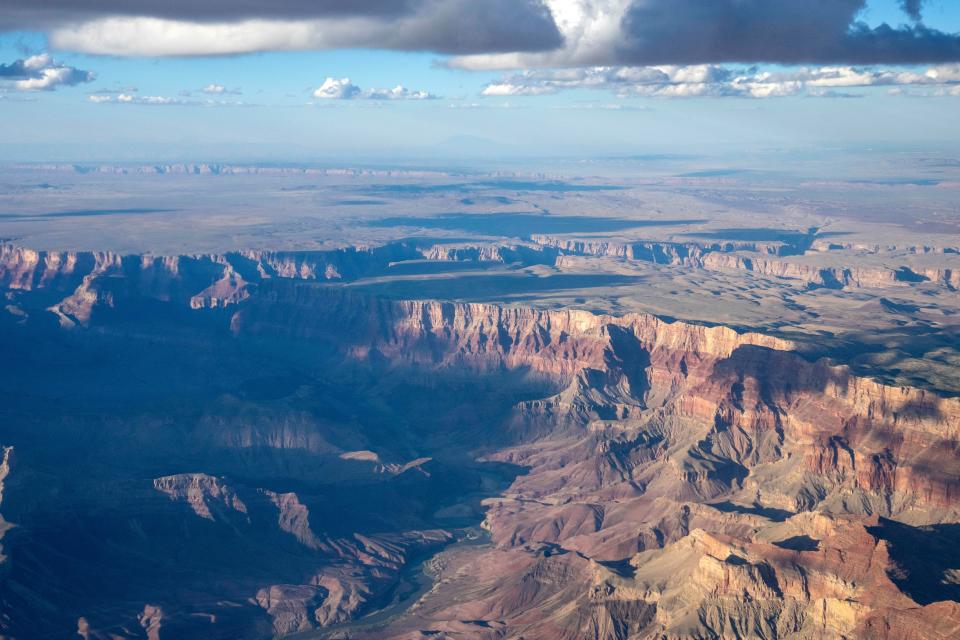Why does the Grand Canyon need a national monument? Take one look and you know
President Joe Biden added his signature to a national project that has been underway now for more than 100 years.
On Tuesday, he joined the historic lineup of U.S. presidents — Benjamin Harrison, Theodore Roosevelt, Woodrow Wilson, Bill Clinton and Barack Obama — who have used their executive authority in three different centuries to preserve a place that has no peer.
The Grand Canyon is where the world cleaved in slow motion over millions of years to reveal its chromatic and geologic complexity.
This magnificent crosscut of prehistoric time yields both scientific discovery and exquisite beauty.
The largest canyon on Earth, it is 10 miles across and 277 miles in length — so massive it is visible from space.
Grand Canyon has delicate beginnings
It is a story writ large.
The human mind can hardly fathom the enormous energy it took to cut a channel so deep across the landscape.
But this is a story with delicate beginnings, snowflakes that glanced off the granite face of Colorado’s Rocky Mountains.
Those snowflakes eventually melted and formed the mighty Colorado River that cut like a knife through the high plains of northern Arizona.
Do we need any more arguments for protecting the Grand Canyon from developers and speculators?
Entrepreneurs wanted to develop it

Had the early entrepreneurs been successful, the Grand Canyon today would be defiled with hydroelectric dams, power lines, scores of working platinum and uranium mines and the sprawl of luxury resorts.
Without national park protection, “there would be mansions of the rich lining the Grand Canyon,” documentarian Ken Burns said.
But the presidents said no.
This is nature’s cut gem. We will preserve its beauty for posterity.
New monument protects sacred lands
With his signature, Biden established a new national monument north and south of Grand Canyon National Park called the Baaj Nwaavjo I’tah Kukveni-Ancestral Footprints.
The name derives from the Havasupai words baaj nwaavjo for “where Indigenous peoples roam,” and the Hopi words i’tah kukveni for “our ancestral footprints,” reports The Arizona Republic’s Brandon Loomis.
“There is no natural treasure, none that is grander than the Grand Canyon,” exulted Interior Secretary Deb Haaland, the first Native American Cabinet secretary.
The new monument protects “thousands of sites that are sacred to the Havasupai, Hopi, Hualapai, Paiute, Navajo, Yavapai-Apache, Zuni and Colorado River Indian Tribes,” Loomis reports.
Good reasons not to mine uranium here
The strongest opposition to Biden’s national monument comes from Republicans who argue it would cut the nation off from its richest reserves of uranium, an element essential to producing nuclear energy.
The monument would make permanent a 20-year ban on mining claims that the Obama administration imposed in 2012.
However, it will not close valid existing mineral claims, Loomis reports. That includes the Pinyon Plain Mine that extracts uranium south of Tusayan.
Why Sinema attended Canyon event: And Ruben Gallego didn't
The uranium reserves near the Canyon represent but a tiny fraction of the U.S. total. The Canyon was never going to solve the nation’s need to import uranium.
Grand Canyon is a wonder to protect
Conservatives argue that geological studies show the Canyon is uncontaminated from years of nearby uranium mining.
But these pages have long argued that the canyon is a “fractured, interconnected geology” that is vulnerable to contamination.
Environmentalists, for example, point to a 1984 flash flood that swept several tons of uranium-laced debris into tributaries of the Colorado River and toward the Grand Canyon.
The Grand Canyon is one of the great natural wonders of the world. It is a national park and as Haaland reminded us, our greatest national treasure.
It is the symbol of our state. The source of its nickname.
And it is an important driver of tourism, attracting nearly 5 million visitors per year.
Thank our presidents for understanding that
This is the paradox the national parks wrestle with, Burns said. “They have to preserve their land for the enjoyment and benefit of the people, but they also have to leave it unimpaired for future generations.”
By taking extraordinary steps to protect the Grand Canyon, President Biden has assured that future generations of Americans and citizens of the world can experience the same astonishment as the first Spanish conquistadors to reach the canyon’s rim in 1540.
Even today, Burns said, “there’s this intimate paradox that you stand on the rim of the Grand Canyon and you feel you’re insignificant, but yet somehow that makes you feel bigger.”
We have a long line of American presidents, the latest being Joe Biden, to thank for that.
This is an opinion of The Arizona Republic's editorial board.
This article originally appeared on Arizona Republic: Grand Canyon national monument continues a legacy

